 One problem with a lot of modern portrait paintings is that they're too specific. Even a realistic portrait should be somewhat iconic. The picture above isn't a picture of of eternal beauty, it's too specifically a painting of Beulah J. Kratz (or whatever her name is). The same problem holds for the other three Lovis Corinth pictures immediately below.
One problem with a lot of modern portrait paintings is that they're too specific. Even a realistic portrait should be somewhat iconic. The picture above isn't a picture of of eternal beauty, it's too specifically a painting of Beulah J. Kratz (or whatever her name is). The same problem holds for the other three Lovis Corinth pictures immediately below.

Actually, this one of the nude holding the hairbrush isn't half bad.
 I don't mean to say that all potraits should be sanitized and idealized. Not at all. But the more specific the picture is the more the style should be iconic, cartoony or deliberately mannered. The picture above by Otto Dix is a good example. It's very specific but it's cartoony and it works.
I don't mean to say that all potraits should be sanitized and idealized. Not at all. But the more specific the picture is the more the style should be iconic, cartoony or deliberately mannered. The picture above by Otto Dix is a good example. It's very specific but it's cartoony and it works.


 Do you agree?
Do you agree?















